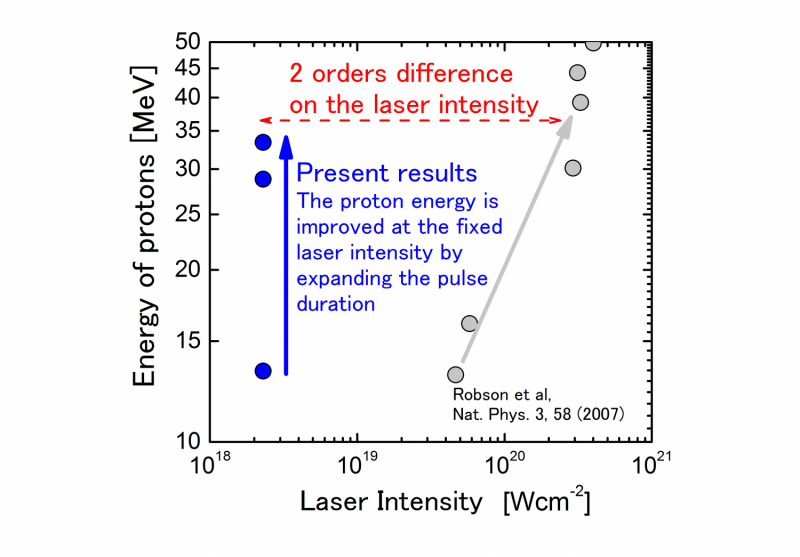Proton beam power boosted with pulsed lasers, promising better proton therapies

A Japan-based research team led by Osaka University demonstrated multiple sharp, ultra-short laser pulses that promise new types of proton-beam systems potentially useful in areas such as cancer treatment. By combining the pulses to effectively create longer pulses, high-energy charged particles can be produced at laser intensities 100 times less than predicted by previous theoretical models. These findings provide insights into construction of more efficient beam facilities.
Beams of charged particles such as protons are used to answer fundamental physics questions and have practical applications in both cancer therapy and fusion power. One way of generating the charged particles for such beams was by directing powerful lasers at metal foils thinner than a human hair. The metal then releases charged particles. Current processes use foils 100 times thinner than a human hair—in this way high-intensity laser light can drive the electrons it hits to near light speeds.
Researchers have thus far used only very short bursts of laser light, each lasting a mere picosecond. When using the pulses, they try to minimize the amount of background light to create sharp (i.e., high contrast) pulses of light. The aim is to increase the energy of the charged particles and achieve beams in which the particles all have very similar energies. Higher energy beams in which the energy of each particle is known exactly are more useful, both in research and for medicine. Although pulsed lasers have shown promise in this area, until recently, the effect of sharp laser pulses longer than one picosecond were unknown.
Now, a Japan-based research team centered at Osaka University has carried out a more detailed study on the use of such laser pulses. They used sharp, ultra-short pulses of laser light from the Laser for Fast Ignition Experiments (LFEX) at Osaka University. LFEX is one of the world's most powerful lasers. The team's study was recently published in the Nature journal Scientific Reports.
LFEX has four extremely powerful laser beams. The researchers used mirrors to focus the laser light down to a point the size of a dust particle. This light was directed at an ultra-thin piece of aluminum foil to generate a cloud of charged particles, referred to as a plasma. Each laser beam is 1018 times more intense than sunlight. Generally such intense power can only be generated for a very short period of time; a challenge underlying why sharp laser pulses longer than one picosecond had not yet been studied.
"By carefully timing the firing of the four beams it was possible for us to effectively fire each in sequence to generate longer pulses that otherwise had the same sharp features as single pulses," study coauthor Hiroshi Azechi says.
The results challenge conventional theoretical models. The researchers found that with their pulsed light, 100 times less intense laser light than previously thought is necessary to produce high-energy charged particles.
"Using multiple pulses to create one longer pulse heats up the electron plasma significantly, which is likely what causes the charged particles to achieve a higher energy at a lower laser intensity," first author Akifumi Yogo says.
Understanding how to create more efficient charged particle beams is a potential key to developing a new generation of particle beams that could advance knowledge of physics and provide better precision tools in the medical field.
More information: A. Yogo et al. Boosting laser-ion acceleration with multi-picosecond pulses, Scientific Reports (2017). DOI: 10.1038/srep42451
Journal information: Scientific Reports
Provided by Osaka University



















